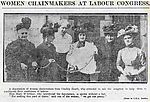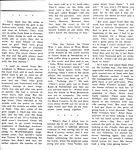 Julia Varley (centre front)
Julia Varley (centre front) Julia campaigned for women's suffrage. She was imprisoned twice.
Julia campaigned for women's suffrage. She was imprisoned twice.  N.F.W.W. leaders - Julia standing on the left
N.F.W.W. leaders - Julia standing on the left Deputation to the Trade Union Congress - Julia standing on the right
Deputation to the Trade Union Congress - Julia standing on the right Julia late in her career
Julia late in her career Interview with Julia 1947 p1
Interview with Julia 1947 p1 Interview with Julia 1947 p2
Interview with Julia 1947 p2

Julia Varley was the first female manual worker to join the ranks of the union leaders. She played a leading role in organising the Cradley Heath women chainmakers' strike in 1910. She can be seen in the first photograph standing at the front of the crowd. At the time she wrote, "We went into the forges, talking to the women as they hammered away, awakening their conciousness to their responsibilities, appealing to their pride and their motherhood." At the Trade Union Congress (T.U.C.) conference that year she chained herself to the platform to draw attention to the women chainmakers' conditions.
Julia was not a native of Cradley Heath, so what brought her there? She was born in 1871, the daughter of a worsted mill worker in Bradford. At thirteen she started work as a sweeper in a woollen mill. At fourteen she was a full time weaver. She quickly became involved in union activity. She became branch secretary of the Weavers' and Textile Workers' Union, and was elected onto the Bradford Trades Council, still aged fourteen.
From the beginning Julia was interested in the needs of working women. From 1904 to 1907 she was a Poor Law guardian in Bradford, and came into contact with "tramping" women. To find out more about their lives, she spent time "on the tramp" from Bradford to Liverpool, disguised as a tramp searching for her husband.
Julia was also a suffragette. She was one of the first to go to prison. She said, "We work shoulder to shoulder with the men in the mills, and in the councils of the workers; why should they deny us the right to help us to choose the men,who make the laws that govern the workers..."
Julia left the suffrage movement to concentrate on trade union organisation. She was one of the first members and organisers of the National Federation of Women Workers (N.F.W.W.), alongside Mary Macarthur. After her success in recruiting chainmakers to the Union, Edward Cadbury invited her to the Midlands. She became secretary to the Birmingham Women Workers' Organisation Committee. She was successful in recruiting womem from many different trades.
Julia left the N.F.W.W. in 1912 to join the Workers' Union, later to become the Transport and General Workers' Union, because she believed men and women should be in the same union.
She remained a very important figure in the Trade Union Movement for the rest of her life. In 1931 she was awarded the O.B.E. for her work. In 1947 she was interviewed for the "Blackcountryman". The interview was re-printed in "The Blackcountryman" in 1975. An extract is included here. Julia died in Bradford in 1952. Of her own life she said, "God has enabled me to see the fruits of my labours, a joy denied to most reformists."
Rollover the captions in the box to see the available images in thumbnail format, click the caption to see the full-size image
| Reference: | 685 |
| Keywords: | |
| Archive Ref: | 2004/034/001 |
| Updated: | Thu 23 Aug 2007 - 0 |
| Interpretation written by | Barbara Harris |
| Author's organisation | |
| Organisation's website |